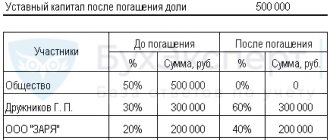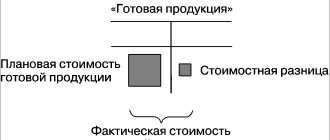Characteristics of account 82
Accounting for reserve capital (hereinafter referred to as RK) is maintained using account 82, designed to collect all information about the state and movement of this type of capital.
To account for the formation of reserve capital, account 82 corresponds with account 84. In special cases, account 82 corresponds with account 75, for example, when forming the Republic of Kazakhstan in non-profit organizations and agricultural enterprises. In order to reflect operations on the use of accumulated reserve capital, the account corresponds with accounts 66 (67).
By studying the features of account 82, you can create the following characteristics of it. This is the account:
- passive, since with its help the sources of the enterprise’s property are taken into account; RK is one of the components of the capital of a joint-stock company and, like all sources of assets, is reflected in the liability side of the balance sheet;
- balance sheet, because its indicators are reflected in the balance sheet;
- stock, since it is intended to account for the sources of formation of funds belonging to the joint-stock company - the capital of the company;
- the main one, because it is intended to control the state and movement of sources of formation of the company’s property (in this case).
You can read about the sources of capital formation in our article “Main sources of equity capital formation.”
Instructions 82 accounts
Instructions for using the chart of accounts for accounting the financial and economic activities of organizations in accordance with Order No. 94n dated October 31, 2000:
Account 82 “Reserve capital” is intended to summarize information about the state and movement of reserve capital. Deductions to reserve capital from profits are reflected in the credit of account 82 “Reserve capital” in correspondence with account 84 “Retained earnings (uncovered loss)”.
The use of reserve capital funds is accounted for as a debit to account 82 “Reserve capital” in correspondence with accounts: 84 “Retained earnings (uncovered loss)” - in terms of the amounts of the reserve fund allocated to cover the organization’s loss for the reporting year; 66 “Settlements for short-term loans and borrowings” or 67 “Settlements for long-term loans and borrowings” - in terms of amounts used to repay the bonds of the joint-stock company.
Contributions to reserve capital - postings
There are several main ways to display the opportunities used to replenish the capital reserve (we will consider them together with transactions on reserve capital) :
- At the expense of retained earnings (according to the norms of paragraph 1 of Article 35 of the Law of December 26, 1995 No. 208-FZ, until the size of the Republic of Kazakhstan, approved by the charter of the joint-stock company, is reached, the amount of deductions made each year cannot be less than 5% of the profit after taxes ( clean)): Dt 84 Kt 82.
- By making contributions by shareholders, participants in non-profit organizations and agricultural enterprises: Dt 75-3 Kt 82 (subaccount 75-3, as a rule, displays other settlements with shareholders (founders)).
As can be seen from the transactions presented above, the replenishment of the reserve capital of account 82 is shown by loan.
Account 82 Reserve capital
In joint stock companies, the amount of reserve capital is created in the amount provided for by the company's charter, but not less than 5% of its authorized capital. The reserve fund of a joint-stock company is formed through mandatory annual contributions until it reaches the size established by the company's charter.
Joint-stock companies must annually contribute at least 5% of net profit to reserve capital. Contributions cease when the reserve capital reaches the amount determined by the charter.
Reserve capital is formed from the organization's retained earnings. Deductions to reserve capital are reflected in the credit of account 82 with the debit of account 84 “Retained earnings (uncovered loss).”
Debit 84 Credit 82 – net profit is used to form reserve capital.
The use of reserve capital funds is accounted for as a debit to account 82 in correspondence with account 84 “Retained earnings (uncovered loss)” in terms of the amounts of the reserve fund allocated to cover the organization’s loss for the reporting year and to repay the bonds of the joint-stock company.
Debit 82 Credit 84 – reserve capital funds were used.
The credit balance of account 82 shows the amount of unused reserve capital at the beginning and end of the reporting period.
Postings when using reserve capital
reserve capital funds 82 is shown as a debit, which is typical for passive accounting accounts. For JSC, only targeted spending of funds of the Republic of Kazakhstan is provided (paragraph 3, paragraph 1, article 35 of Law No. 208-FZ):
- Repayment of bonds issued by the joint-stock company - Dt 82 Kt 66 (67) - is made at the expense of the Republic of Kazakhstan in the event of a shortage of other funds from the company. At the same time, the above transaction will only increase the debt on the bonds, since the Republic of Kazakhstan is not property, but only a source.
- Redemption of issued shares - Dt 82 Kt 81. In this case, the Republic of Kazakhstan, rather, plays the role of a source of covering losses from transactions for the redemption of securities, since for the actual redemption of its shares, money (assets) is still needed, not sources. Therefore, despite the fact that this posting is used in practice, it is better to use cash accounting accounts instead of account 82 in such postings.
- Coverage of losses received - Dt 82 Kt 84. In accounting, this operation is regarded as an event occurring after the reporting date. The mechanics of this operation are as follows: based on the results of consideration on the basis of sub. 12 clause 1 art. 65 of Law No. 208-FZ, the supervisory board makes a decision to cover incurred losses at the expense of the Republic of Kazakhstan.
How is reserve capital formed and used?
Reserve capital is created from the net profit of the organization.
Amount of reserve capital:
- For a JSC there must be at least 5% of the authorized capital;
- LLCs determine the value at their own discretion.
Amount of contributions to the reserve:
- For JSC, at least 5% of net profit per year;
- LLCs determine the value at their own discretion.
Purposes of using reserve capital:
- Loss coverage;
- Redemption of own bonds;
- Redemption of own shares.
The size of the authorized capital of most LLCs is small and usually amounts to 10,000 rubles. The amount of reserve capital directly depends on the size of the management company and amounts to a small amount of 10,000 rubles. Therefore, reserve capital for most LLCs is of a formal nature and does not solve the problem of covering the organization’s losses.
Results
All operations carried out related to changes in reserve capital on account 82 are displayed both as credit and debit. The receipt of funds (replenishment of the Republic of Kazakhstan) is shown as a credit to this account, and the use of funds is shown as a debit.
According to the Chart of Accounts approved by the Ministry of Finance, it is assumed that the “Reserve Capital” account corresponds only with accounts 66 (67) and 84. In some cases, it is practiced to use an entry with account 75 when forming a capital account from contributions of shareholders, founders of non-profit organizations.
You will find more information on the use of accounting accounts in our article “Instructions for the chart of accounts for 2015.”
You can find more complete information on the topic in ConsultantPlus. Free trial access to the system for 2 days.
Formation of a reserve fund and posting to account 82
Let us give examples of business transactions for the formation of a reserve fund and postings to account 82.
Example No. 1. Additional accrual of the reserve fund in connection with legal requirements
Let’s assume that a private security company (PSC) had a capital account balance as of December 31, 2009:
- Account balance 80 - 10,000 rubles;
- Account balance 82 - 1,000 rubles;
- Account balance 84 – 41,000,000 rubles.
The company's charter provides for the creation of a reserve fund in the amount of 10% of the amount of its authorized capital. The reserve fund has been formed in full.
In December 2009 Amendments were made to the law “On Private Security Activities”, in particular, the authorized capital of a private security company providing armed security services cannot be less than 250,000 rubles.
In January 2010 the organization brought the amount of authorized and reserve capital into compliance with the law.
Postings for the formation of the reserve fund in account 82, made in the organization in January 2010:
| Dt | CT | Amount (rub.) | Contents of a business transaction | Document |
| 75 | 80 | 240 000 | The amount of the authorized capital has been increased | Charter in the new edition, decision of the founders |
| 84 | 82 | 24 000 | Additional reserve capital has been added | Charter, accounting certificate-calculation 240000*10%=24000 |
The private security company's balance in its authorized and reserve capital accounts as of January 31, 2010 was:
- Account balance 80 – 250,000 rubles;
- Account balance 82 - 25,000 rubles.
HIGHLIGHTS OF THE WEEK
05/21/20214:15 Accounting and reporting
New SZV-M from May 2021: differences from the previous form
20.05.202116:00
Special modes
New notice from the Federal Tax Service for “patent” entrepreneurs
24.05.202113:39
Business organization
The rules for issuing passports are changing - from July 1
24.05.202115:11
Personnel
We calculate salaries and advances for May 2021, taking into account non-working days
20.05.202112:15
Personnel
The new SZV-M form was approved
PODCAST 4.12.2020
What has changed in taxes and reporting since 2021?
All episodes
Comments on documents for an accountant
Recommendations for identifying unjustified tax benefits have been published
05/25/2021 Article 54.1 of the Tax Code of the Russian Federation contains provisions aimed at combating the receipt of unjustified tax...
Should I use cash register when issuing or repaying a microloan?
05/25/2021 A microloan is a loan provided by a microfinance company on the terms provided for...
Are social benefits from the employer subject to contributions?
05/25/2021 The object of taxation is insurance contributions (pension, medical and social in case of temporary…
‹Previous›Next All comments
Accounting for reserve capital
Reserve capital is the insurance capital of an organization, intended to cover losses from business activities, as well as repay the organization’s bonds and repurchase its own shares in the absence of other funds.
The creation of the organization's reserve capital is carried out in accordance with the legislation of the Russian Federation and the constituent documents of the organization. The formation of reserve capital is carried out at the expense of the organization’s net profit.
Reserve capital is required to be created by joint-stock companies; at their discretion, it can also be created by enterprises of other forms of ownership, if this is provided for by their constituent documents and accounting policies.
In joint stock companies, the amount of reserve capital must be at least 5% of the authorized capital. Reserve capital is formed by mandatory annual contributions in the amount of at least 5% of net profit until the amount established by the company's charter is reached.
To account for the state and movement of reserve capital, account 82 “Reserve capital” - passive.
Opening balance (loan) - the amount of reserve capital at the beginning of the reporting period.
Credit turnover is an increase in reserve capital.
Debit turnover is a decrease in reserve capital.
Closing balance (loan) - the amount of reserve capital at the end of the reporting period.
Example
The charter of OJSC Olympus provides for the creation of reserve capital in the amount of 3,000,000 rubles. According to the charter, 5% of the company’s net profit is annually transferred to reserve capital. The amount of the company's reserve capital as of January 1, 200_ is 2,700,000 rubles.
The net profit of OJSC "Olimp" at the end of 200_ amounted to 6,500,000 rubles; 5% of this amount will be 325,000 rubles. Net profit in the amount of 300,000 rubles will be allocated to reserve capital.
The following entry will be made in the accounting records:
Dt 84 Kt 82,300,000 rub. — part of the profit of the reporting year is used to form reserve capital.
Synthetic accounting register - journal order No. 12.
Analytical accounting is carried out according to the stages of formation and directions of use of reserve capital funds.
When an organization uses an automated form of accounting using the 1C: Enterprise software product, the registers of synthetic accounting are the turnover of account 82 (General Ledger), analysis of account 82, balance sheet, etc. The analytical accounting registers are the balance sheet for account 82, analysis of account 82 for sub-accounts, turnover between sub-accounts, account card 82, account card 82 for sub-accounts, etc.
Main correspondence for account 82 “Reserve capital”
| Contents of operations | Debit | Credit |
| Net profit was used to form reserve capital | 84 | 82 |
| Interest accrued on short-term and long-term bonds of joint-stock companies issued to attract short-term and long-term loans if other funds are insufficient | 82 | 66, 67 |
| Reserve capital funds are used to repay losses | 82 | 84 |








